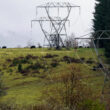The question of what to do with Sweet Home’s Oregon Electric Railroad depot is one that warrants serious consideration from residents and leaders.
The depot isn’t much to look at, we admit. It’s painted kind of a dull golden yellow and its windows are boarded up. It lacks elaborate carvings or other features that might endear it to the classic-building crowd.
It is, apparently, fairly sturdy, as demonstrated by the fact that it survived, intact, after being recently dragged four blocks by a large bulldozer from behind McDonald’s to its current location in the city Public Works Maintenance Yard at the end of 24th Avenue.
And it’s visible history, something with which Sweet Home isn’t well-endowed. Let’s be blunt: There aren’t very many period buildings in Sweet Home, a town that was built with little planning and in some haste, as the condition of much of the infrastructure and housing reveals.
As we reported in our Feb. 19 edition, city officials are trying to determine what to do with the depot.
As reported last week, Public Works Director Mike Adams, who’s responsible for the property on which the depot currently sits, has said he plans to contact the Rick Franklin Corporation, which owns and operates the Albany and Eastern rail line, to find out if the company has any interest in acquiring the old Oregon Electric Railroad depot.
While we certainly agree with Adams that the depot shouldn’t sit “out of sight and out of mind,” we would suggest that a move to get rid of it is premature. Although it’s taking up space in the city yard, that’s a good place for it, at least until we see how things play out across the tracks in what is proposed to be a new county park.
If that park does materialize, and it appears that there’s still plenty of momentum along those lines, it’s hard to imagine a more appropriate use for the depot than in the park as some type of visitor’s center or park office.
While Councilman Craig Fentiman has rightly pointed out how Weddle Bridge has become the city’s responsibility despite early assurances that that would not be the case, hanging on to the depot isn’t really costing the city anything except a little space. If it could be incorporated into a park, upkeep would be part of that park maintenance and could be funded with fees associated with the use of that park.
The fact is, as we’ve pointed out previously, thus far Rick Franklin Corporation has demonstrated little concern for anything but its own interests in regard to the Albany and Eastern railroad line. Piles of fallen trees and jagged stumps alongside the tracks attest to that, as do exposed homes and yards of its neighbors.
That business-like approach does not bode well for the future of a historic building that’s going to need some work. If Sweet Home were flush with ornate, period structures, such as we see throughout neighboring communities, we would be less moved to advocate strongly for the preservation of a building that looks somewhat ramshackle in its present state.
But Sweet Home doesn’t have that architectural heritage and the depot is a piece of local history. That’s why Sweet Home should be in no rush to dictate its future.
We don’t believe it’s overly melodramatic to suggest that the preservation and proper placement of this structure is critical for our community.




